
Concrete – the building material of a 1.5°C world?
On 22.12.2019 by Johannes TiefenthalerBy Johannes Tiefenthaler
Bridges, tunnels, buildings – concrete plays a key role in our daily life. How is it manufactured? Can it be recycled? What is its climate impact? Read on and you’ll find out how we can decarbonize concrete.
From limestone to concrete
Switzerland has 450 concrete plants and uses 14 million m³ of it every year; making it the most widely used building material. Being such a heavy and large product, transport distances have to be short to remain competitive – making it a local and regional business. In addition to sand and gravel, which can be found in nature, concrete manufacturing requires cement, which is an energy- and CO2 emission-intensive industrial process. Cement is obtained by grinding limestone with so-called clinker, which is the “magic” binder responsible for the strength of the concrete. To produce 1 ton of clinker, 1250 kg limestone are required, which when heated to above 600°C (necessary for the production of clinker), decompose and release 550 kg CO2 (fig.1). From an energy requirements perspective, producing 1 ton of clinker requires 115 kg of coal, which emit around 290 kg CO2. 1m³ concrete (equal to 2.5 tons) contains on average 320 kg cement, 160 kg water, 2000 kg sand and gravel and emits 230 kg CO2.

Figure 1: The plot puts the raw materials for clinker and cement in perspective with the CO₂ emissions.
Renewable energies alone cannot stop climate change
Cement manufacturing in responsible for 85% of the overall concrete manufacturing emissions. 3 million tons CO2 or 6% of Swiss inland GHG emissions are accounted to the concrete sector in 2017. In a world with only CO2-free energy, emissions from coal and concrete operations can be mitigated. However, the calcination of limestone to create clinker still releases 1.7 Mt CO2 in Switzerland. Reducing emissions by 45% (from 3 Mt CO2) is a big achievement – but it is not good enough to stop global warming.
In Paris, 195 countries agreed on limiting global warming to well below 2°C. This implies that all anthropogenic emissions with a global warming effect have to go to zero between 2040 and 2060. But here comes the problem: using renewable energies does not allow decarbonizing the cement industry, because the problem is not the energy, it is the emissions due to the thermal decomposition of limestone!
What does the sector do to reduce emissions?
Today, the cement sector has two major emission reduction strategies.
- Incineration of waste: By replacing coal by car tires, solvents and plastics, CO2 emissions are reduced since these wastes emit up to 50% less fossil CO2 than coal.
- Use of less clinker in cement: different types of cements require different amounts of clinker. This approach effectively reduces emissions – however, every cubic meter of concrete requires at least 160 kg clinker, therefore there is a limit to the CO2 emission reduction.
All other emission reduction measures, like energy efficiency measures or waste heat recovery have a very limited effect on the CO2 balance of cement.
Does cement recycling reduce emissions?
In addition to reducing the clinker amount in cement, recycling cement could be an option to reduce the CO2 emissions related to the decomposition of limestone. However, cement cannot be recycled as cement. But concrete (containing cement) is recycled as a replacement for gravel and sand in recycling concrete. Recycling concrete is concrete with a recycling material content of more than 40% by weight. There are quality issues associated with the use of recycling materials. EMPA realized with interviews to over 10 concrete plant owners, that there is 5-10% more cement in recycling concrete to overcome quality issues – effectively increasing CO2 emissions.

Figure 2: A concrete crushing operation on a Swiss concrete recycling plant.
How can a future, climate neutral cement and concrete sector look like?
The only way to stop emitting CO2 is by using carbon capture and storage (CCS) technologies in concrete production. CCS is in operation at full scale since 1996 in Sleipner, Norway. All components are proven technologies. CCS technologies were specifically developed to mitigate CO2 emissions from large industrial point sources like cement manufacturing. The first component in the technological chain is the CO2 capture step, where CO2 is removed from the cement flue gas. The purified CO2 is afterwards liquefied for transport per truck, train, ship or pipeline to a storage place. There is basically one main option to store CO2 permanently at the required scale:
- Geological CO2 storage
CO2 is stored in saline aquifers or exploited oil and gas fields. Aquifers that qualify for CO2 storage need to show the following characteristics:
- The CO2 storage reservoir needs to be at a depth below 800 m. Over there, CO2 is in a liquid like state, exhibiting a high density and flowability
- The rock where CO2 is stored needs to be highly porous and the pores have to be well connected to allow the CO2 to flow
- The CO2 storage rock has to be overlayed by a non-porous cap rock to keep the CO2 in the storage reservoir
Geological storage reservoirs are able to store billions of tons of CO2 globally. Norway plans to make their CO2 storage site available for Europe in 2023.
However, the public opinion about CO2 storage is very divided, since it is perceived as risky and end of pipe solution are not popular.
Can CO2 be recycled and create a positive climate impact?
To create a positive climate impact, the CO2 stemming from cement manufacturing needs to be used in a way that it does not enter the atmosphere again. Even if the product is consumed, the CO2 cannot be emitted – which is the case for most chemicals and fuels. Otherwise, the CO2 gets again climate active.
Here one other permanent storage option: CO2 can be transformed into calcite rock inside the pores of demolition concrete. This procedure creates value by densifying the demolition concrete – which has advantages for the reuse of the material. Furthermore, this allows to store CO2 in a safe manner. The amount of CO2 stored depends very much on the amount of demolition concrete recycled. In Switzerland, demolition concrete can store today 200 kt and in 2050 1M t of CO2 (fig.3). Therefore, it represents a significant CO2 sink, however due to the scale not an alternative to geological storage – since current Swiss CO2 emissions are about 50 Mt per year.

Figure 3: The CO2 storage potential in demolition concrete is obtained by delaying the cement manufacturing process emission by the average life time of a building (80 years). It can be seen, that the CO2 storage capacity doubles every 10 years. Considering technological and market limitations, we expect that the actual CO2 storage capacity in demolition concrete will reach about 1Mt in 2050.
Summarizing, 350 kg CO2 per Swiss inhabitant are emitted due to concrete manufacturing every year. 2/3 of these emissions stem from the burning of limestone for cement manufacturing. While demand side measures can reduce the amount of clinker produced, CCS technologies are required to decarbonize the still manufactured clinker. CCS cleans the cement flue gas from CO2 and stores it permanently geologically or as minerals. Is it already done? The first CO2 capture plant installed at a cement plant will go online in Norway in 2024.
Should CCS be deployed to decarbonize cement even if CCS has no business case?
I believe the more important question is: In which world do we want our children to live in? Can we justify the risk and uncertainty induced by climate change to obtain a bit cheaper construction materials? In Paris, the global society said NO!
CCS is only a tool to decarbonize cement. A market driven CCS deployment relies very much on a new market equilibrium, in which CO2 neutral cement is cheaper to produce than CO2 emitting cement. A CO2 tax can provide these incentives. The knowhow is there. The technologies are there. The societal momentum is there. Let’s start implementing!
So why is it not done yet?
Keep up with the Energy Blog @ ETH Zurich on Twitter @eth_energy_blog.
Suggested citation: Tiefenthaler, Johannes. “Concrete – the building material of a 1.5°C world?”, Energy Blog @ ETH Zurich, ETH Zurich, December 22, 2019, https://blogt.ethz.ch/energy/concrete-1-5c-world
If you are part of ETH Zurich, we invite you to contribute with your findings and your opinions to make this space a dynamic and relevant outlet for energy insights and debates. Find out how you can contribute and contact the editorial team here to pitch an article idea!

